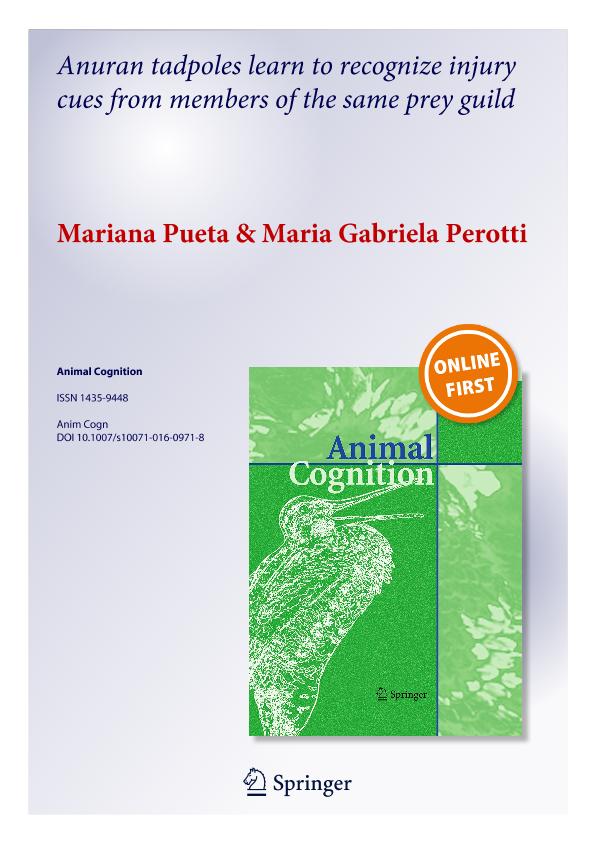Mostrar el registro sencillo del ítem
dc.contributor.author
Pueta, Mariana

dc.contributor.author
Perotti, Maria Gabriela

dc.date.available
2018-12-10T15:15:35Z
dc.date.issued
2016-07
dc.identifier.citation
Pueta, Mariana; Perotti, Maria Gabriela; Anuran tadpoles learn to recognize injury cues from members of the same prey guild; Springer Heidelberg; Animal Cognition; 19; 4; 7-2016; 745-751
dc.identifier.issn
1435-9448
dc.identifier.uri
http://hdl.handle.net/11336/66178
dc.description.abstract
Recognition of predation risk from cuesreleased from injured heterospecific could be beneficialwhen prey belongs to the same prey guild. Here, we performedthree experiments. Experiment 1 showed that P.thaul tadpoles reduced their activity levels when exposedto conspecific injury cues, but not when exposed toamphipod injury cues. Experiment 2 tested whether P.thaul tadpoles can learn to recognize predation risk fromchemical cues released from injured heterospecifics fromthe same prey guild (amphipod, Hyalella patagonica). Agroup of tadpoles were conditioned by exposing them to aspecific concentration of amphipod injury cues paired withconspecific injury cues. Two days later, we evaluatedchanges in the activity of tadpoles when they were exposedto amphipod cues. As a control of learning, we used anunpaired group. Additionally, we used more control groupsto fully investigate the learning mechanism. Our resultsshowed that tadpoles can learn to recognize predation riskfrom injured amphipods and that the mechanism underlyingthe observed learned response could be associative.Experiment 3 replicated Experiment 2 and also showed thata low concentration of amphipod cues did not sustain thatlearning.
dc.format
application/pdf
dc.language.iso
eng
dc.publisher
Springer Heidelberg

dc.rights
info:eu-repo/semantics/openAccess
dc.rights.uri
https://creativecommons.org/licenses/by-nc-sa/2.5/ar/
dc.subject
Associative Learning
dc.subject
Anuran Tadpoles
dc.subject
Amphipods
dc.subject
Predation Risk
dc.subject.classification
Otras Ciencias Biológicas

dc.subject.classification
Ciencias Biológicas

dc.subject.classification
CIENCIAS NATURALES Y EXACTAS

dc.title
Anuran tadpoles learn to recognize injury cues from members of the same prey guild
dc.type
info:eu-repo/semantics/article
dc.type
info:ar-repo/semantics/artículo
dc.type
info:eu-repo/semantics/publishedVersion
dc.date.updated
2018-11-13T20:36:05Z
dc.journal.volume
19
dc.journal.number
4
dc.journal.pagination
745-751
dc.journal.pais
Alemania

dc.journal.ciudad
Heidelberg
dc.description.fil
Fil: Pueta, Mariana. Consejo Nacional de Investigaciones Científicas y Técnicas. Centro Científico Tecnológico Conicet - Patagonia Norte. Instituto de Investigaciones en Biodiversidad y Medioambiente. Universidad Nacional del Comahue. Centro Regional Universidad Bariloche. Instituto de Investigaciones en Biodiversidad y Medioambiente; Argentina. Universidad Nacional del Comahue. Centro Regional Universitario Bariloche; Argentina
dc.description.fil
Fil: Perotti, Maria Gabriela. Consejo Nacional de Investigaciones Científicas y Técnicas. Centro Científico Tecnológico Conicet - Patagonia Norte. Instituto de Investigaciones en Biodiversidad y Medioambiente. Universidad Nacional del Comahue. Centro Regional Universidad Bariloche. Instituto de Investigaciones en Biodiversidad y Medioambiente; Argentina
dc.journal.title
Animal Cognition

dc.relation.alternativeid
info:eu-repo/semantics/altIdentifier/doi/https://dx.doi.org/10.1007/s10071-016-0971-8
dc.relation.alternativeid
info:eu-repo/semantics/altIdentifier/url/https://link.springer.com/article/10.1007/s10071-016-0971-8
Archivos asociados
